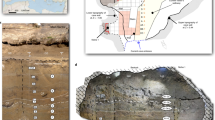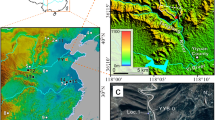Abstract
The human skeletal remains from the Vogelherd cave in the Swabian Jura of southwestern Germany are at present seen as the best evidence that modern humans produced the artefacts of the early Aurignacian1. Radiocarbon measurements from all the key fossils from Vogelherd show that these human remains actually date to the late Neolithic, between 3,900 and 5,000 radiocarbon years before present (bp). Although many questions remain unresolved, these results weaken the arguments for the Danube Corridor hypothesis2—that there was an early migration of modern humans into the Upper Danube drainage—and strengthen the view that Neanderthals may have contributed significantly to the development of Upper Palaeolithic cultural traits independent of the arrival of modern humans3,4.
This is a preview of subscription content, access via your institution
Access options
Subscribe to this journal
Receive 51 print issues and online access
$199.00 per year
only $3.90 per issue
Buy this article
- Purchase on Springer Link
- Instant access to full article PDF
Prices may be subject to local taxes which are calculated during checkout


Similar content being viewed by others
References
Churchill, S. E. & Smith, F. H. Makers of the Early Aurignacian of Europe. Yb. Phys. Anthropol. 43, 61–115 (2001)
Conard, N. J. & Bolus, M. Radiocarbon dating the appearance of modern humans and the timing of cultural innovations in Europe: new results and new challenges. J. Hum. Evol. 44, 331–371 (2003)
Richter, J. ‘Out of Africa II’ Die Theorie über die Einwanderung des modernen Menschen nach Europa auf dem archäologischen Prüfstand. Archäol. Inform. 19, 67–73 (1996)
D'Errico, F. The invisible frontier. A multiple species model for the origin of behavioral modernity. Evol. Anthropol. 12, 188–202 (2003)
Boule, M. Les Hommes Fossiles (Mason et Cie, Paris, 1921)
Stringer, C. & Gamble, C. Search of the Neanderthals (Thames & Hudson, London, 1993)
Klein, R. The Human Career, 2nd edn (Univ. Chicago Press, Chicago, 1999)
Stringer, C., Hublin, J. J. & Vandermeersch, B. in The Origins of Modern Humans (eds Smith, F. & Spencer, F.) 51–135 (Alan Liss, New York, 1984)
Henry-Gambier, D. Les fossiles de Cro-Magnon (Les Eyzies-de-Tayac, Dordogne): nouvelles données sur leur position chronologique et leur attribution culturelle. Bull. Mém. Soc. Anthropol. Paris 14, 89–112 (2002)
Svoboda, J. The depositional context of the Early Upper Paleolithic human fossils from the Konĕprusy (Zlatý kůň) and Mladeč caves. Czech Republic. J. Hum. Evol. 38, 523–536 (2000)
Svoboda, J., van der Plicht, J. & Kuželka, V. Upper Paleolithic and Mesolithic human fossils from Moravia and Bohemia (Czech Republic): some new 14C dates. Antiquity 76, 957–962 (2002)
Riek, G. Die Eiszeitjägerstation am Vogelherd im Lonetal I (Heine, Tübingen, 1934)
Riek, G. Paläolithische Station mit Tierplastiken und menschlichen Skelettresten bei Stetten ob Lontal. Germania 16, 1–8 (1932)
Conard, N. J., Niven, L., Mueller, K. & Stuart, A. The chronostratigraphy of the Upper Paleolithic of Vogelherd. Mitt. Ges. Urgesch. 12, 73–86 (2003)
Gieseler, W. Bericht über die jungpaläolithischen Skelettreste von Stetten ob Lontal bei Ulm. Verh. Ges. Phys. Anthropol. 8, 41–48 (1937)
Gieseler, W. Die urgeschichtlichen Menschen-Funde aus dem Lonetal und ihre Bedeutung für die deutsche Urgeschichte. Jahresbande Wiss. Akad. Tübingen NCD Dozentbundes 1, 102–127 (1940)
Czarnetzki, A. in Urgeschichte in Baden-Württemberg (ed. Müller-Beck, H.) 217–240 (Konrad Theiss, Stuttgart, 1983)
Churchill, S. E. & Smith, F. H. A modern human humerus from the early Aurignacian of Vogelherdhöhle (Stetten, Germany). Am. J. Phys. Anthropol. 112, 251–273 (2000)
Scholz, M. et al. Genomic differentiation of Neanderthals and anatomically modern man allows a fossil-DNA-based classification of morphologically indistinguishable hominid bones. Am. J. Hum. Genet. 66, 1927–1932 (2000)
Bruhn, F., Duhr, A., Grootes, P. M., Mintrop, A. & Nadeau, M.-J. Chemical removal of conservation substances by ‘Soxhlet’-type extraction. Radiocarbon 43, 229–237 (2001)
Grootes, P. M., Nadeau, M. J. & Rieck, A. 14C AMS at the Leibniz-Labor: radiocarbon dating and isotope research. Nuclear Instruments and Methods (in the press)
Nadeau, M. J. et al. The Leibniz-Labor AMS facility at the Christian-Albrechts-University, Kiel, Germany. Nucl. Instrum. Methods B 123, 22–30 (1997)
Stuiver, M. & Polach, H. Discussion: reporting of 14C data. Radiocarbon 19, 355–363 (1977)
Smith, F. H., Trinkaus, E., Pettitt, P. B., Karavanić, I. & Paunović, M. Direct radiocarbon dates for Vindija G1 and Velika Pećina Late Pleistocene hominid remains. Proc. Natl Acad. Sci. USA 96, 12281–12286 (1999)
Trinkaus, E. et al. An early modern human from the Peştera cu Oase, Romania. Proc. Natl Acad. Sci. USA 100, 11231–11236 (2003)
Beck, J. W. et al. Extremely large variations of atmospheric 14C concentration during the last glacial period. Science 292, 2453–2458 (2001)
Hughen, K. A. et al. 14C activity and global carbon cycle changes over the past 50,000 years. Science 303, 202–207 (2004)
Voelker, A. H. L., Grootes, P. M., Nadeau, M. J. & Sarnthein, M. Radiocarbon levels in the Iceland Sea from 25–53 kyr and their link to the earth's magnetic field intensity. Radiocarbon 42, 437–452 (2000)
Van Kreveld, S. et al. Potential links between surging ice sheets, circulation changes, and the Dansgaard-Oeschger cycles in the Irminger Sea, 60–18 kyr. Paleoceanography 15, 425–442 (2000)
Hublin, J. J., Barroso Ruiz, C., Medina Lara, P., Fontugne, M. & Reyss, J.-L. The Mousterian site of Zafarraya (Andalucia, Spain): dating and implications on the palaeolithic peopling processes of Western Europe. C.R. Acad. Sci. 321, 931–937 (1995)
Acknowledgements
We are grateful to M. Bolus, C. Pusch, H. Floss, M. Haidle, M. Malina, L. Niven and E. Trinkaus for their assistance and discussions, and we thank the Leibniz team for cleaning and dating the bones. This work was funded by the Landesdenkmalamt Baden-Württemberg, the Alb-Donau-Kreis, the Deutsche Forschungsgemeinschaft, the Alexander von Humboldt Stiftung, and the Eberhard-Karls-Universität Tübingen.
Author information
Authors and Affiliations
Corresponding author
Ethics declarations
Competing interests
The authors declare that they have no competing financial interests.
Rights and permissions
About this article
Cite this article
Conard, N., Grootes, P. & Smith, F. Unexpectedly recent dates for human remains from Vogelherd. Nature 430, 198–201 (2004). https://doi.org/10.1038/nature02690
Received:
Accepted:
Issue Date:
DOI: https://doi.org/10.1038/nature02690
This article is cited by
-
Denisovans, Neanderthals, and Early Modern Humans: A Review of the Pleistocene Hominin Fossils from the Altai Mountains (Southern Siberia)
Journal of Archaeological Research (2022)
-
A parsimonious neutral model suggests Neanderthal replacement was determined by migration and random species drift
Nature Communications (2017)
Comments
By submitting a comment you agree to abide by our Terms and Community Guidelines. If you find something abusive or that does not comply with our terms or guidelines please flag it as inappropriate.



